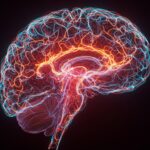A recent study examined the impact of neurofeedback training when added to the standard rehabilitation treatment of individuals suffering from alcohol use disorder. The researchers found that individuals who received this training, along with the standard rehabilitation treatment, showed increased emotional competencies and higher life satisfaction compared to their peers who only underwent the standard alcohol rehabilitation treatment. The research was published in Social Cognitive and Affective Neuroscience.
Alcohol use disorder is a medical condition characterized by an inability to control alcohol consumption despite negative consequences on health, relationships, and daily responsibilities. It ranges from mild to severe, depending on the number and severity of symptoms, such as cravings for alcohol, withdrawal from social interactions, and continued drinking despite harm. Individuals with this disorder often develop a tolerance for alcohol, where more alcohol is needed to achieve the same effects, and physical dependence, where stopping alcohol use causes withdrawal symptoms.
Researchers believe that impaired emotional competencies may play a key role in the development of alcohol use disorder. A lack of these competencies also hinders efforts to stop alcohol use, leading to relapse. Impaired emotional competencies include reduced awareness of one’s own emotions, a diminished ability to recognize and perceive the emotions of others, and challenges in experiencing and managing emotions. They also involve issues with emotional self-efficacy, acceptance of emotions, and the ability to imagine and process emotional experiences effectively.
Study author Ramona L. Hack and her colleagues wanted to see whether adding EEG neurofeedback training to a standard alcohol rehabilitation treatment could improve participants’ emotional competencies and thus enhance the overall treatment outcome. EEG neurofeedback training is a therapeutic technique that uses real-time monitoring of brainwave activity (via electroencephalography – EEG) to help individuals learn to regulate their brain function.
The training system converts brainwave activity, which cannot be detected without special devices, into auditory or visual signals that a person can hear or see. This allows the individual undergoing neurofeedback training to learn to self-regulate brain activity in a way that produces the desired signal (i.e., the desired brainwaves). As these brainwaves can reflect a person’s inner psychological states, learning to regulate brainwave activity also helps individuals learn to regulate their own psychological state, in this case, to regulate their emotions.
The study participants were 56 individuals diagnosed with alcohol dependence syndrome, 23 of whom were female. The study authors randomly divided them into two groups. One group received “treatment as usual,” meaning they underwent the regular alcohol rehabilitation program. The other, experimental group, received neurofeedback training optimized for their condition in addition to the standard alcohol rehabilitation program. On average, the control group was older than the experimental group (49 years vs. 41 years old).
Before and after the treatment, study participants completed assessments of their emotional levels (using the Scales for Experiencing Emotions), compulsion to drink alcohol (using the Obsessive-Compulsive Drinking Scale), depressive symptoms (using the Beck Depression Inventory II Revision), cognitive strategies (using the Questionnaire of Dysfunctional and Functional Self-Consciousness), coping strategies (using the Stress Coping Questionnaire), impulsivity (using the Impulsive Behavior Scale), and life satisfaction (using the Life Satisfaction Self-Report Scale).
The EEG neurofeedback training consisted of two parts. In the first part, participants learned to regulate their sensorimotor brainwave rhythm, while the second part focused on regulating alpha/theta brainwaves. As feedback, participants viewed a graph depicting their current brainwaves. Their task was to ensure that the graph turned green instead of red. Each part lasted around 20 minutes, and participants completed 15 training sessions. The standard alcohol rehabilitation treatment involved psychotherapy, art therapy, and medical/physical training.
Results showed that participants who underwent neurofeedback training improved in emotion regulation and had a significant decrease in “Lack of Emotions” scores. In contrast, the control group, which underwent standard rehabilitation, did not show changes in these assessments. The changes in the neurofeedback training group were moderate in size.
The neurofeedback training group also reported increased life satisfaction compared to the control group. Both groups showed a decrease in compulsions to drink alcohol.
“Improvements on the clinical-psychological level, i.e., increases in emotional competences as well as life satisfaction were found after the experimental EEG-neurofeedback training. Neurophysiological measurements via resting state EEG indicate decreases in low beta frequency band [type of brainwaves], while alpha and theta band [another type of brainwaves] remained unaffected,” the study authors concluded.
The study sheds light on the potential of neurofeedback training to improve the emotional competencies of individuals with alcohol use disorder. However, it should be noted that, for most of the study participants, alcohol use disorder was not the only psychiatric diagnosis. Additionally, the effects observed were on emotional competencies, not on any of the direct symptoms of problematic alcohol use.
The paper, “Brain regulation training improves emotional competences in patients with alcohol use disorder,” was authored by Ramona L Hack, Martin Aigner, Michael Musalek, Richard Crevenna, and Lilian Konicar.




